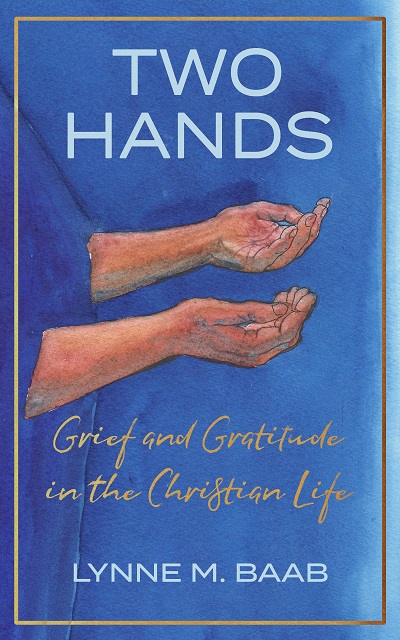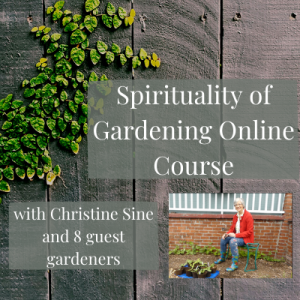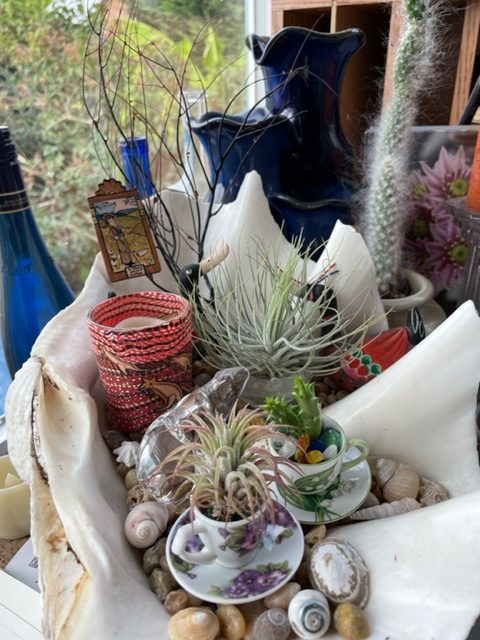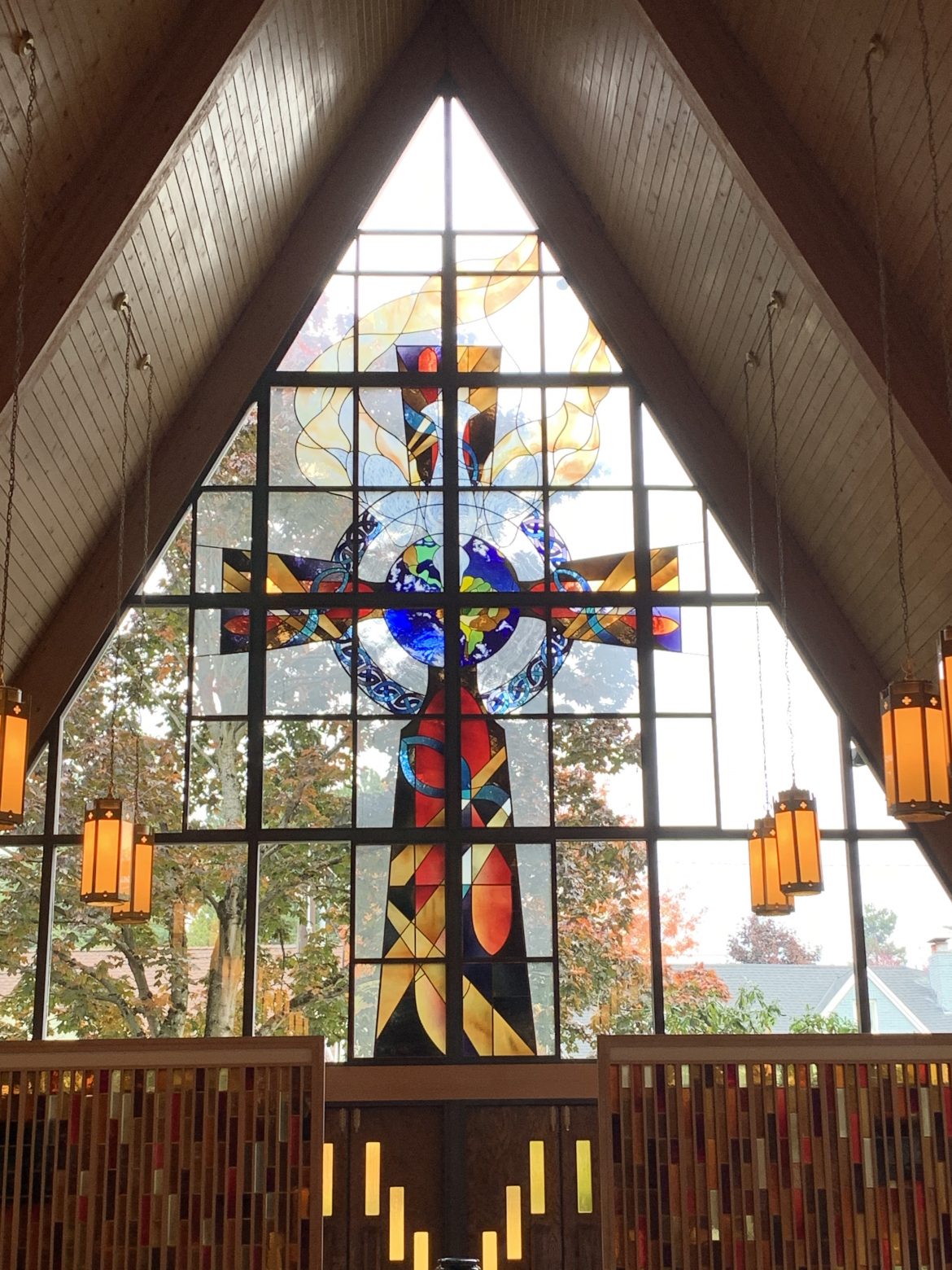My spouse and I travelled to central France to visit the famous Celtic-inspired abbeys of Faremoutiers and Jouarre that were both founded in the 7th century following the rather rigid Rule of Columbanus composed by the Irish monk Columbanus. I had become enthralled with studying and writing about the early Celtic and Anglo-Saxon saints including Abbess Theodechilde of Jouarre, France and wanted to see firsthand where this saint had lived and served.
7th century Theodechilde (Theodechildis) was born in an area known as Neustria around modern-day Paris. She began her monastic life as a nun in Faremoutiers Abbey in France which is about 60 miles southeast of the center of Paris. Amazingly, 1400 years later, Faremoutiers Abbey is still in existence even though it has been rebuilt over the years, but on the same grounds. Even though Faremoutiers Abbey was in France, it was described as a double monastery which was a uniquely Celtic way of monastic living. Double monasteries were religious foundations ruled by an Abbess in which monks and nuns lived on the same monastic grounds, worshipped in the same church, yet lived in separate houses designated for nuns and monks.
Bishop Burgundofaro (Bishop Faro) of Meaux, France wanted to transform Jouarre Abbey which had been established around 630AD into a double monastery. He must have been a brave Bishop to buck the long-standing Roman Catholic tradition of convents for nuns and monasteries for men, each on their own monastic lands
To accomplish this, Bishop Burgundofaro asked his sister Abbess Burgundofara of Faremoutiers if she would release Theodechilde to become Abbess of the soon-to-be revolutionized monastery. Jouarre Abbey would then be like the double monastery of Faremoutiers Abbey. Theodechilde was released from Faremoutiers Abbey and she became Abbess of Jouarre. This double monastery flourished under her leadership and became so well-respected that one of Abbess Theodechilde’s nuns was sent to become the first Abbess of the newly formed Chelles Abbey outside of Paris and also another of her nuns became the first Abbess of Soissons Abbey.
Even though many of the well-known Celtic and Anglo-Saxon saints have no physical reminders of their burial places, one can still visit the Merovingian crypt beneath the church of Jouarre Abbey where both Abbess Theodechilde and her brother Bishop Agilbert are buried. Agilbert became Bishop of Paris after serving as Bishop of the West Saxons in England and was with the Roman delegation at the history making Synod of Whitby in 664. Each of these two siblings’ sarcophagi are magnificent. Agilbert’s stone sarcophagus has carvings of Christ in Majesty and the Last Judgment. The photo at the top of this post is Abbess Theodechilde’s stone sarcophagus which is carved with scallops along with these beautiful and touching words in Latin that are translated into English:
“This tomb contains the remains of blessed Theodechilde, virgin of noble race, valiant in works, ardent in faith, mother of this monastery. She taught her daughters to run to meet Christ like the wise virgins, their lamps filled with oil. She now rejoices in paradise.”
May these same things be said of us someday, that we too were valiant in works, ardent in faith, and our soul’s inner light was continually filled with the oil of the Spirit.
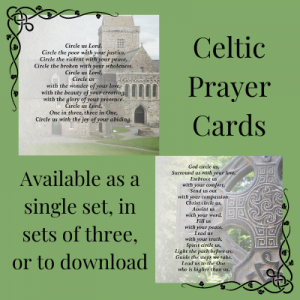 Celtic Prayer Cards include 10 prayers inspired by ancient Celtic saints like Patrick or contemporary Celtic writers like John O’Donohue. A short reflection on the back of each card will introduce you to the Celtic Christian tradition, along with prayers by Christine Sine and beautiful imagery crafted by Hilary Horn. Celtic Prayer Cards can be used year-round or incorporated into various holidays. Available in a single set of 10 cards, three sets, or to download.
Celtic Prayer Cards include 10 prayers inspired by ancient Celtic saints like Patrick or contemporary Celtic writers like John O’Donohue. A short reflection on the back of each card will introduce you to the Celtic Christian tradition, along with prayers by Christine Sine and beautiful imagery crafted by Hilary Horn. Celtic Prayer Cards can be used year-round or incorporated into various holidays. Available in a single set of 10 cards, three sets, or to download.
by Christine Sine artwork~ Retablo by: Lynn Garlick www.garlickretablos.com
I love cooking especially as the weather grows colder and Christmas approaches. I love the resulting gatherings, dinner conversations and the delight that people often express in what I make. More recently I enjoyed putting together the recipes for our upcoming Godspacelight Community Cookbook which I hope will stir others to cook, eat and enjoy time together.
A couple of weeks ago I received a small icon of St Drogo the patron saint of coffee, coffee-drinkers, cafes, and baristas. That got me thinking Who is the patron saint of tea, and what other patron saints hover round us as we cook and drink and celebrate? In a few weeks we celebrate All Saints Day so this seemed like a great time to honor those who might surround us as we cook and eat.
1. St. Nicholas of Syracuse — Patron of baking, confectionaries, chocolatiers
Feast: Dec. 6 St Nicholas is better known to us as Santa Claus and the bringer of gifts. Because of this 4th-century bishop’s association with children and Christmas, he is considered the patron of everything sweet. For a wealth of information, stories, plays, recipes, and customs about St. Nicholas, how his image evolved into Santa Claus, and how to celebrate his feast as part of Advent, see www. stnicholascenter.org.
2. St. Hyacinth — Patron of pierogi
Feast: Aug. 17 Hyacinth was known as the “Apostle of the North”. He preached the Gospel in Lithuania, Denmark, Sweden and Norway, lands associated with pierogi — those magnificent Polish dumplings — sweet or savory, fried or boiled — made from unleavened dough. As legend has it, on July 13, 1238, Hyacinth visited the town of Kościelec, Poland, which had just experienced a devastating storm that destroyed all of the local crops, bringing its population to the brink of starvation. Hyacinth prayed and the crops were saved. In a show of gratitude, the townsfolk created pierogi from the renewed crops. He was said to have walked the streets of Kraków handing out pierogi, which were a luxury food item of the time, to the poor, destitute and needy.
3. St. Drogo — Patron of coffee, coffee-drinkers, cafes, and baristas
Feast: April 16. 12th-century Drogo was the son of a Flemish nobleman who could somehow be in two places at the same time. He was seen tending the fields and at daily Mass at the same time. He also took 10 pilgrimages to Rome on foot. How he became the patron saint of coffee is puzzling; coffee was not introduced to Europe until the 15th century. Evidently, Clement VIII was the first pope to try coffee, which had the reputation of being the “Devil’s Drink.” While some of the cardinals asked the Pope to ban it, Clement rather enjoyed it. “This devil’s drink is delicious. We should cheat the devil by baptizing it.”
4. Dom Justo Takayama Ukon — Patron of tea
Feast: Feb. 3 Justo Takayama Ukon was a 17th-century Japanese samurai and daimyō martyr who was particularly fond of tea and enjoyed the spiritual aspects of the Japanese tea ceremony. Conversions brought about through the help of Dom Justo are believed to number in the tens of thousands during an era in which the oppressive regime of Chancellor Toyotomi Hideyoshi was bearing down on Catholic Christians. The samurai renounced his fiefdom, walking away from worldly power and voluntarily embracing poverty over obedience to a despot. He lived under the protection of friends and allies for several decades, but in 1614, when Toyotomi’s successor prohibited the Christian faith outright, Dom Justo left Japan from Nagasaki, leading 300 Catholics into exile in Manila, Philippines, so they could again practice their faith. He died there, forty days later, the only daimyō to be buried on Philippine soil.
5. St. Elizabeth of Hungary — Patron of bakers, and baking
Feast: Nov. 17. The 13th-century Elizabeth distributed bread to the poor every day. In 1228, Elizabeth joined the Secular Franciscan Order, spending the remaining few years of her life caring for the poor in a hospital which she founded in honor of Saint Francis of Assisi. Elizabeth’s health declined, and she died before her 24th birthday in 1231. Her great popularity resulted in her canonization four years later.
6. St. Arnulf of Metz/Arnouf — Patron of beer, and bartenders
Feast: July 18. Born in Lorraine around AD 580, Arnulf was a bishop of Metz when dysentery hit his city. He reasoned that it was due to the drinking water. He pleaded with his flock to avoid drinking water and replace it with beer. The epidemic stopped instantly and, as reported, everyone had a more positive outlook on life afterward.
7. St. Urban of Langres — Patron of wine, vintners, sommeliers
Feast: Jan. 23 In 374, Urban, a French bishop had to flee his diocese due to political turmoil and hid in a vineyard. The vine-dressers in the area concealed him, and he took the opportunity to convert them to Christianity. Those same vine-dressers then helped him in his covert ministry, as he moved from one town to another via their vineyards. Urban developed great affection to all the people in the wine industry, and they for him.
8. St. Neot — Patron of fish fries
Feast: July 31 St. Neot, was a four-foot-tall monk from Glastonbury, England, who died in 877. Pius legend has it that on his deathbed, Neot’s brother monk went to retrieve fish living in a nearby well. An angel had previously assured Neot that the three fish currently living in the well would never decrease as long as Neot ate no more than a single fish each day. Neot’s caretaker, being unfamiliar with the angel’s assurance, retrieved two of the fish to strengthen Neot’s failing health. Upon finding out about the monk’s error, Neot prayed for forgiveness and ordered that the now cooked and very dead fish be returned to the well. As they entered the water, both Neot and the fish were returned to life.
9. St. Lawrence of Rome — Chefs, sommeliers, cooking, comedians
Feast: Aug. 10. St. Lawrence is the go-to patron saint of cooking. Upon being convicted by Christian-hating Roman pagans, Lawrence was sentenced to death by being slow-roasted over an open fire. Reputedly, his last words were, “Turn me over, I’m done on this side!” And that, is why St. Lawrence is the Patron of chefs.
10. St. Isidore the Farmer — Farmers, greengrocers
Feast: May 15. Spanish saint Isidore was a farmer all his life. He rose early in the morning to go to church and spent many a holiday devoutly visiting the churches of Madrid and surrounding areas. All day long, as he walked behind the plow, he communed with God. His devotion, one might say, became a problem, for his fellow workers sometimes complained that he often showed up late because of lingering in church too long. Unsurprisingly, he became the patron of farmers.
11. St. Brigid of Kildare — Patron of cheese and cheesemakers
Feast: Feb. 1 The 5th-century Brigid. is remembered as a fine monastic leader, a spiritual guide and a healer. She and her double monastery (she presided over both men and women) were known for their generous hospitality and their compassionate care for the sick, the poor and the oppressed far beyond the gates of the monastery. Her generosity and hospitality are some of the reasons she is now the patron of cheese, and my personal friend.
12. St. Abigail — Patron of bees and honey
Feast: Feb. 11 St. Abigail, also known as Deborah and Gobnait, was born in the 6th century in County Clare, Ireland, but ran away from home due to family problems. After she spent some time in French convent, she returned to Ireland and a colony of bees took up residence at the bow of her boat, which ferried her home to Ireland. She used their honey in her preparations to cure illnesses. Our awareness of the crucial role bees play in pollination make St Abigail a very important person for us to celebrate
13. St. Martha of Bethany — Patron saint of cooks, waiters, waitresses
Feast: July 29. Martha, Mary and Lazarus often feted Jesus and his Apostles at dinner. One day, Mary seemed to be shirking her duties in the kitchen and Martha urged Jesus to ask her sister to lend a hand in the kitchen instead of listening to Jesus. Jesus gently admonished Martha by reminding her that Mary choose the contemplative life rather than the life of service (Luke 10:38-42). Irma Rombauer chose St Martha for the cover of the first edition of her “The Joy of Cooking”. She got her daughter, Marion, to do the cover art, which is a drawing of St Martha, handbag in one hand, broom in another, and what looks like a dinner plate for a halo, slaying a dragon, which is presumed to be the dragon of kitchen chores. In other words, Irma chose for the cover of her first book someone who just gets into the kitchen, and gets things done.
14. St. Honoré — Patron saint of bread, bakers and those who make altar bread
Feast: May 16. St. Honoré has been associated with bread for more than a thousand years. His patronal church in Paris was the site of the bakers’ guild and many pastry shops and boulangeries are named after him. In Paris his feast day is celebrated with three-day bread festivals. The eponymously-named Gateau St. Honoré is a cream-filled puff pastry still used as a First Communion cake in France.
15. St. Nicholas of Tolentino — Patron saint of vegans and vegetarians
Feast: Sept. 10. This Italian saint was a dedicated vegetarian. He once received a Marian apparition when he was seriously ill, and the Blessed Mother told him he’d be cured if he ate bread dipped in water. From that moment onward, he cured many people by giving bread and water to them. According to a pious legend, a host once gave Nicholas a dish of fried chicken to eat, not knowing that Nicholas was a vegetarian. The saint thanked his benefactor and prayed over his plate. At that, the chicken was instantly transformed into roasted vegetables.
16. St. Hildegard of Bingen — Patron saint of nutritionists, recipe collectors, and chefs
Feast: Sept. 17. St Hildegard of Bingen, Doctor of the Church was a prolific writer. Her writing covered many topics, including the subjects of medicine, botany, theology, and liturgy. She also composed songs, wrote plays, and experienced visions. She also wrote recipes and engaged in nutritional science and believed food had healing properties. She created her “Cookies of Joy” which were meant to promote good health and cheerfulness, saying, “They will reduce the bad humors, enrich the blood, and fortify the nerves.”
17. St. Bibiana – patron of teetotalers, hangovers and New Year’s resolutions
Feast: Sept. 1. Virtually nothing is known about St Bibiana except her martyrdom in the 4th century. It is said that upon her burial “mysterious and magical herbs” grew up around her grave and that it was these herbs that worked the miracles. A church was built over her grave in Rome. In the Middle Ages pilgrims to the holy site of Santa Bibiana would scrape dust from its columns and eat it which worked the same hangover magic as the original herbs did.
18. St. Macarius The Younger – Patron of candy makers
Feast : January 2. Young Macarius was a successful businessman who made and sold candy and sweet pastries in Egypt in 335. Inspired by stories of holy men who had fled civilization for a life of prayer and penance, Macarius gave up his candy business and spent a good part of his life in a bare one-room house, living much like a hermit.
19. St. Vincent – Patron of Wine
Feast: January 22. Nothing in St. Vincent’s life has a true connection to wine. It is believed his association with wine came about simply because of his name. In French, the word for wine is vin and in Italian it is vino. Another reason St. Vincent may be associated with wine is that red wine reminded Christians of St. Vincent’s bloody martyrdom. During barbaric oppression of Christians, Vincent refused to deny Christ. He was imprisoned and tortured and eventually died from his injuries. His bloody clothes were preserved as relics to his martyrdom.
20. St. Pasqual of Baylon – Patron of the Kitchen
Feast: May 17. Pasqual of Baylon is remembered mostly for his extraordinary devotion to the Eucharist and his heroism in the face of danger. He was also noted for his strict austerities, as well as his love for and compassion towards the sick. As a humble friar he never wasted food. The end of each week saw him eat a few boiled vegetables which had been soaked in water with the terrible-smelling weed known as wormwood. He often ate scraps from the kitchen. In his native Spain, and in Latin America, he revered as the Patron Saint of the Kitchen.
 Next Facebook Live!
Next Facebook Live!
Join Christine Sine and Lilly Lewin for a discussion on Pilgrimage. Wednesday, September 21st at 9 am PT. Happening live in the Godspace Light Community Group on Facebook – but if you can’t catch the live discussion, you can catch up later on YouTube!
…there are more wonderful chats on hospitality!
Since the last hospitality round-up there were two more Facebook Live sessions on hospitality. #icymi Christine and Lilly had another chat on hospitality and the gift of life:
Christine also had a fascinating chat with Edith and Randy Woodley on hospitality and the gift of land:
As always you can catch any FB Live chats on Christine’s YouTube channel within a day or two of the live session!
…Christine has been practicing hospitality through the gift of beautiful prayers
Christine has been experimenting with videos, especially short reels on Instagram, to gift you with some prayers and meditations. Such as this one on her Instagram:
View this post on Instagram
Christine also made a video that includes a bunch of these short meditations, which you can also find on her YouTube channel:
… we are transitioning Godspace admin!
Melissa Taft will be moving on from the position soon, though she will continue to write for Godspace occasionally. Stay tuned for introductions to Christine’s new assistant!
… and speaking of staying tuned, yummy things are coming!
We have enjoyed receiving your recipes and anecdotes for our Godspace Community Cookbook. We are working on putting it all together now and will keep you updated as to when it will be available for purchase!
… we hope you have enjoyed our hospitality series, here are some recent highlights!
We are wrapping up our hospitality theme Embracing the Wild Hospitality of God and leaning into our new theme, Gratitude as Guests of the World. We did a seasonal-themed repost of oldies-but-goodies hospitality posts. We dug up some timely reflections and paired them with some delicious recipes. You can find them all here:
We hope these resources are a blessing to you.
 Looking for hospitality inspiration? We have an entire resource page dedicated to hospitality. Find recipes and reflections on numerous hospitality topics, including Celtic hospitality, prayers, and liturgies. Click on Hospitality for more!
Looking for hospitality inspiration? We have an entire resource page dedicated to hospitality. Find recipes and reflections on numerous hospitality topics, including Celtic hospitality, prayers, and liturgies. Click on Hospitality for more!
Editor’s Note: As we transition into the season of gratitude, we acknowledge for some it is not an easy one. You may be dealing with a personal crisis or affected by the many world-wide events currently happening. We hope this repost of Lynne Baab’s post on grief and gratitude will encourage and nourish you in the midst.
by Lynne Baab
I was raised by a hyper-optimistic mother. All problems, she believed, should be faced with an upbeat attitude. Grief was okay – as long as it was brief. And grieving was limited to deaths of loved ones and major catastrophes.
As a young adult I discovered Jeremiah’s sadness and angst. He experienced and expressed emotions I had always considered to be negative, and his honesty before God felt soothing and healing. Later the wild and passionate emotions of the Psalms gave me further permission to experience a wide variety of feelings, including sadness and anger, and to bring those emotions into God’s presence.
My journey of learning how to deal with “negative” emotions was further enhanced in 2019, when I came across a quotation by psychotherapist Francis Weller: “The work of the mature person is to carry grief in one hand and gratitude in the other and to be stretched large by them.” Godspace’s curator Christine Sine wrote a post about the quotation from Weller last month. She mentions that she first heard the quotation in a book that she found very valuable. That book is now out – Two Hands: Grief and Gratitude in the Christian Life – and I am the author.
The book is the fruit of two years of pondering and trying to learn to live with grief in one hand and gratitude in the other, and to allow myself to be stretched large by both of them. One of my major insights is that the very nature of the Christian Gospel involves both grief and gratitude. We grieve the brokenness and pain in our world that made it necessary for Jesus to come to earth, and we rejoice and give thanks that he did. We juxtapose this grief and gratitude every time we have Holy Communion. We hold grief in one hand and gratitude in the other simultaneously.
In pondering this picture of two hands, I spent a lot of time in the psalms, where a pattern of pain/anger/grief almost always shifts to thanks/praise. I am fascinated by the pivot points in many psalms of lament. These pivot points make clear that sometimes the grief hand is quite heavy and full, and other times the thankfulness hand predominates.
Psalm 77 begins with expressions of sadness and pain, and then in verse 10 the psalm writer describes the way their perspective has changed: “And I say, ‘It is my grief that the right hand of the Most High has changed.’” The second half of the psalm is filled with thanks and praise.
So often when we are grieving we feel that God is distant and uninvolved. Psalm 10 begins with 13 verses of anger and grief about the prosperity of the wicked. Then in verse 14 the psalm writer expresses great joy at God’s involvement in human life: “But you do see! Indeed you note trouble and grief, that you may take it into your hands; the helpless commit themselves to you.”
In this journey of grief and gratitude, I have learned that the extreme optimism I was raised with has continued to influence me. I have a strong practice of thankfulness that my husband and I began more than 25 years ago, and the consistent practice of gratitude has been transforming. This recent journey focused on two hands has revealed that deep inside, I always expected that if I could only be thankful enough, then I wouldn’t feel sad about anything. Finding so many places where grief and gratitude are juxtaposed in the Bible has helped me understand that grief will always be a significant factor in human life on earth simply because our brokenness is so profound. We can honestly grieve human pain and selfishness, as well as natural disasters and nasty viruses, while we also give thanks for God’s amazing gifts: the fresh air after a rain, the soft fur on a kitten or puppy, the sweetness of fresh fruit, a glorious sunset, the delights of a good novel, an interesting conversation with friends, the hug of a child.
I am hoping churches might recommend my book for Advent or Lent, since the themes fit those church seasons so well. Each chapter has discussion questions, so small groups can discuss it. I’ll close with Christine Sine’s endorsement for my book, a thrilling affirmation that this journey I’ve been on will be helpful for others, too.
“Two Hands: Grief and Gratitude in the Christian Life is one of the most important books I have read in the last few months. I have long been an advocate for gratitude as a way of life, but Lynne Baab helped me understand that grief is just as important and often the missing element in our practices. We all need a better understanding of how grief and gratitude intertwine in a healthy life. This is a must-read book for everyone as we emerge from the challenges of the COVID pandemic.”
As an Amazon Associate I receive a small amount for purchases made through appropriate links. Thank you for supporting Godspace in this way.
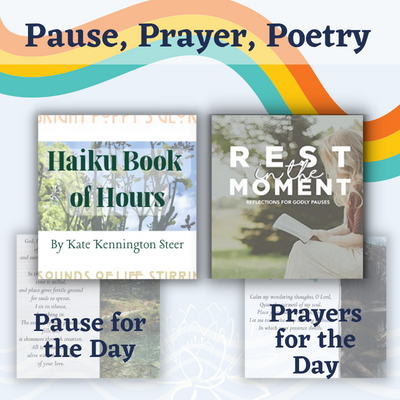 Whether you are praying the stations of the day, in need of resources for rest, hoping to spark joy and find wonder, or simply want to enjoy beautiful prayers, poetry, and art – our digital downloads section has many options! Christine Sine’s book Rest in the Moment is designed to help you find those pauses throughout the day. Praying through the hours or watches, you may find inspiration in our prayer cards set Prayers for the Day or Pause for the Day. You may find your curiosity piqued in the free poetry and art download Haiku Book of Hours. All this and more can be found in our shop!
Whether you are praying the stations of the day, in need of resources for rest, hoping to spark joy and find wonder, or simply want to enjoy beautiful prayers, poetry, and art – our digital downloads section has many options! Christine Sine’s book Rest in the Moment is designed to help you find those pauses throughout the day. Praying through the hours or watches, you may find inspiration in our prayer cards set Prayers for the Day or Pause for the Day. You may find your curiosity piqued in the free poetry and art download Haiku Book of Hours. All this and more can be found in our shop!
by Elaine Breckenridge, featured photo Dancing Monk Icon by Marcy Hall and © Abbey of the Arts, used with permission
Since his death in 1226, and his canonization in 1228, the legacy of St. Francis lives on. He is so compelling that you can walk into any number of home improvement stores or plant nurseries, and buy a statute of his likeness for your garden. He is associated with all of creation, the elements and animals. This contemporary icon of Francis pictures him with a fox, a salmon and a bird.
Francis is famous for saying, “Preach the Gospel at all times and when necessary, use words.” He did just that at a cathedral on Christmas Eve, 1223. Francis brought in a donkey, sheep and cows; a manger, a newborn baby and a young woman and man, and set up the first living nativity scene in history. It was the forerunner to the Christmas crèche–still enacted in Christmas pageants and a sacred commodity that can be purchased in numerous places.
On that Christmas Eve, Francis was making a not-so-subtle statement. For Francis, the world looked like the Garden of Eden. Remember that the church in the time of Francis believed that creation itself was sinful and evil. The perspective of Francis was radically different. By bringing animals into the church, he made it clear that creation itself was and is sacred. All things, whether living or inanimate, reflected God the Creator’s love and were thus due reverence and wonder.
In this spirit many Christian Churches have practiced gathering people and animals together around the time of the Feast of St. Francis to bless both pets and animals. Perhaps many of you will have an opportunity to take your pet to church for a blessing. Some churches invite people to bring their pets right into the building for the church service. Some do not. Many churches hold their pet blessings before or after the regular church service and it can be difficult to leave a pet in the car for that length of time. Or perhaps you own farm animals and they are bit more difficult to bring to church. Or perhaps you are not a member of a church community that offers a blessing for animals.
I wonder, why not offer a blessing of your pets and animals at home? One does not have to be an ordained minister to bless animals. St. Francis was certainly not.
Francis is so revered as a Saint that many forget he was never ordained a priest or bishop in the Roman Catholic Church of his time. He founded a religious order and the lay people took vows, but Francis always considered that the world was his monastery, not the walls in which he lived and prayed. On the icon pictured above, the words “The world is my monastery” are attributed to St. Francis. (Christine Valters Paintner, Illuminating the Way, Embracing the Wisdom of Monks and Mystics p. 3) It was only after his death that the Franciscan Order came under the full authority of the church.
In the spirit of St. Francis, I hope you will have some opportunity to have your animals blessed at church or at home this week. And if you need some words for a ritual and blessing at home, I offer a liturgy that I have put together for your use.
Think of it as a template. It is meant to be flexible and can be used by an individual, or in a community with a designated or shared leadership. It is intentionally brief keeping in mind that a gathering could include many animals and children! And yet it can be shortened or lengthened if you have elements that you would like to add. You have my blessing to use it in any way you wish. But, I ask you not to publish it as I plan do to so in the future.
Of course, there are other ways to celebrate the life of St. Francis. If you do not own a pet, you may choose to bless a beloved plant or favorite tree. You could watch a sunrise or sunset in his name or take a contemplative walk giving thanks for the elements, the landscape and all that you see on that walk.
However we may choose to celebrate the life of St. Francis, may we remember that blessing creation, is to name it as good. As we do so we express our gratitude and love for God, the Creator of all that is.
* * *
A FORM OF BLESSING FOR ANIMALS
Glorious God, we give you greeting!
Let Sister Earth and Brother Sun praise you
Let the fields and forests praise you
Let the birds and beasts praise you
Let everything that has breath praise you,
Mother and Father of all that has being.
– A Holy Island Prayer Book by Ray Simpson p. 37
A Reading from the Book of Genesis
God said, “Let the waters bring forth swarms of living creatures, and let birds fly above the earth across the dome of the sky.” So, God created the great sea monsters and every living creature that moves, of every kind, with which the waters swarm and every winged bird of every kind. And God saw that it was good. God blessed them, saying, “Be fruitful and multiply and fill the waters in the seas, and let birds multiply on the earth.” And there was evening and there was morning, the fifth day. And God said, “Let the earth bring forth living creatures of every kind: cattle and creeping things and wild animals of the earth of every kind.” And it was so. God made the wild animals of the earth of every kind and the cattle of every kind and everything that creeps upon the ground of every kind. And God saw that it was good. (Genesis 1:20-24)
Reader: Hear what the Spirit is saying to God’s People.
People: Thanks be to God.
A Reading from the Christian Tradition
If I were alone in a desert and feeling afraid, I would want an animal to be with me. For then my fear would disappear and I would be made strong. This is what life in itself can do because it is so noble, so full of pleasure and so powerful. Therefore, let those who bring about wonderful things take an animal to help them. The life within the animal will give them strength in turn. For equality gives strength, in all things and at all times.
-Meister Eckhart, “Benediction for the Animals,” in Earth Prayers, p. 253.
Reader: Hear what the Spirit is saying to God’s People.
People: Thanks be to God.
Individual blessings may be offered over each animal and it may be touched if appropriate using these words:
“Peace be with you, my friend.”
When all the animals have been blessed, the people may say to one another,
“Peace be with you, my friend.”
Final Prayer of Blessing
Blessed are you Lord God, maker of all living creatures. You called forth fish in the seas, birds in the air and animals on the land. You inspired St. Francis to call all of them his brothers and sisters. We give you thanks for all these animals and those who care for them. By the power of your love, enable them and all of us to live in peace. Amen.
Glory to you, O God for all of your creation. May we sing your praises and give you thanks forever. Amen.
© The Rev. Elaine H. Breckenridge
As an Amazon Associate I receive a small amount for purchases made through appropriate links. Thank you for supporting Godspace in this way
Explore the wonderful ways that God and God’s story are revealed through the rhythms of planting, growing, and harvesting. Spiritual insights, practical advice for organic backyard gardeners, and time for reflection will enrich and deepen faith–sign up for 180 days of access to work at your own pace and get ready for your gardening season.
It’s been a hard week. First the devastating floods in Pakistan, the horrifying impact of Hurricane Ian in Cuba and Florida, and growing fears of a global recession that sent stock markets crashing and brought the fear of poverty and hunger into poor families everywhere. On a personal level it seems every time I turn round I hear of another friend or family member who has COVID or cancer.
It’s challenging in the midst of all of this to introduce our new theme Gratitude as Guests of the World. As many of you know, October and November have long been my gratitude months, instituted several years ago as a season of thanksgiving that spans Canadian and American Thanksgiving. However as Norm Wirzba says in his new book Agrarian Spirit, ”For gratitude to be effective and take hold in our world, it has to touch kindling and catch fire. Generosity is the fire that is sparked by gratitude.” Seeing ourselves as guests of the world and hosts to the world is an effective way to kindle the fire and create the atmosphere of generosity and gratitude so necessary for us and all creation to flourish and for those of us who have resources to reach out and help those who have none.
How do we accomplish this? One of my favourite practices which propel me into my season of gratitude is setting up a new contemplative garden. Over the last couple of weeks I gathered gifted items that really make me feel like a guest in our world. I admired the beautiful giant clam shell given to me a few weeks ago specifically to use in one of my contemplative gardens. I added some of my favourite shells and barnacle-encrusted memorabilia gifted by the sea during my beach combing expeditions, a small icon of St Drogo, the patron saint of coffee, which gives me a huge lift every time I look at it and a couple of tiny tea cups. To these I added plants received as gifts and a few ornaments given to me around the world. The trouble with this garden is that I have so many gifted items that hold a special place in my heart, that I did not know what to display.
As I put my garden together, admiring each item and remembering the stories that go with them, my sense of gratitude grew until it was like a fire that wanted to burst out and sweep the world with generosity. I am indeed a guest in this world and a very special guest at that. I am also called to be a host to all those who suffer and are in need of my generosity. “Freely you have received, freely give.” Jesus reminds us in Matthew 10:8. The following verses are very much about being guests in the world as the disciples are encouraged to go out without money or extra clothing or a place to stay. Everything they receive will be a gift. Now I know, I am stretching the interpretation of this passage when I suggest that every gift we receive should be viewed in this light but the way generosity bubbles up inside me when I admire the gifts given to me, makes me think that every gift should be viewed in this light.
As I sit and admire my garden today, I think of Lilly Lewin, sitting in her hotel room in Budapest in COVID isolation and asking herself what she calls the pilgrim question: What are the gifts of today? then adding the question What are the gifts you are grateful for today (FreerangeFriday: What are the gifts of today?)? When we see ourselves as guests of the world it is so much easier to count the gifts that are abundant around us. In fact I find that this attitude makes me live in anticipation of God’s gifts, and has me hyper-aware, watching and waiting to see what God will gift me with next. And then, in the spirit of “pay-it-forward”, I want to gift others too. Recognizing the gifts of God overflowing around us is a wonderful way to start a season of gratitude and generosity.
Take time to walk around your house today and note items gifted to you. Stop and look at them. If they are small, pick them up and hold them in your hands. What is special about each item? What memories do they evoke? Sit and immerse yourself in these memories for a couple of minutes. Close your eyes and imagine yourself as a guest being overwhelmed with special gifts from God. What is the response that bubbles up within you?
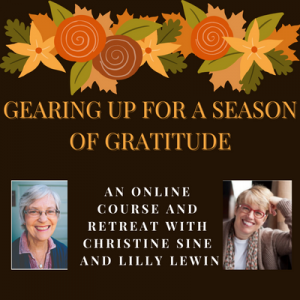 Christine Sine and Lilly Lewin inspire ways to get geared up for the coming season of gratitude in this popular online course! Sign up for 180 days to enjoy this retreat at your own pace – including craft tutorials and print-outs plus much more. Check it out in our shop!
Christine Sine and Lilly Lewin inspire ways to get geared up for the coming season of gratitude in this popular online course! Sign up for 180 days to enjoy this retreat at your own pace – including craft tutorials and print-outs plus much more. Check it out in our shop!
A contemplative service with music in the spirit of Taize. Carrie Grace Littauer, prayer leader, with music by Kester Limner and Andy Myers.
Permission to podcast/stream the music in this service obtained from One License with license #A-710-756.
Thank you for praying with us!
As an Amazon Associate, I receive a small amount for purchases made through appropriate links.
Thank you for supporting Godspace in this way.
When referencing or quoting Godspace Light, please be sure to include the Author (Christine Sine unless otherwise noted), the Title of the article or resource, the Source link where appropriate, and ©Godspacelight.com. Thank you!




